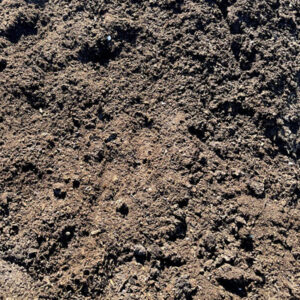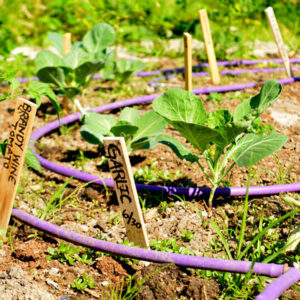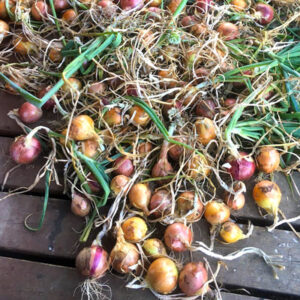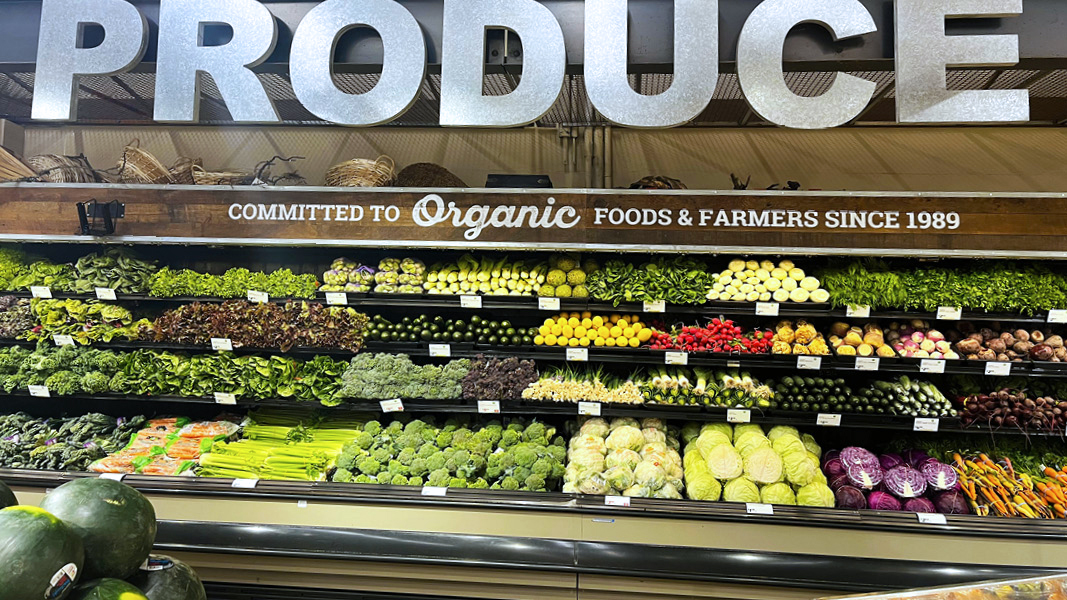Top: The selection of organically grown produce has expanded exponentially at supermarkets over the years.
 Sally Brown
Sally Brown
The National Academy of Sciences just released a report, “Exploring Linkages Between Soil Health and Human Health.” In it, the authors suggest that the links between the two are real although not well understood. In other words, healthy soil on some level makes for healthy people. That doesn’t mean that you should integrate a few spoonfuls of healthy soil into your kale smoothie. Instead of eating dirt, the logical step, at least in most people’s mind, is to eat organic. Organic foods are the product of organic or healthy soils, right? The connection seems obvious even if the reality is somewhat muddy.
First some basics on soil health. After decades of chemical dependence, us soil scientists are coming to the realization that a proper diet and more exercise, just like for people, is the way to restore soils to better health and increased productivity. That translates into increased use of organics like manures, composts and biosolids. It also means not leaving soils naked. Growing things are what soils are supposed to do. Forget winter fallow; instead put on a cover crop so the soil can stay warm and active.
There is now an emerging field of regenerative agriculture, growing to not only get more food but to restore soils — soils exposed to too many chemicals react the same way your gut microbiome does to too many antibiotics. I just read Call of the Reed Warbler, a book presenting the Australian version of this. Years back I read Growing a Revolution by David Montgomery that presented the U.S. version. On the list of books to read is his new one, coauthored by his wife Anne Bilkey, What Your Food Ate. It may have inspired the National Academy committee to make its strong argument that healthy soils grow healthier foods.
Recycled Organics Are Integral
The main messages in restorative agriculture are to increase diversity of what is grown, avoid chemicals and increase soil organic matter. A point that is made in the books that I have read is that soils will, if given the opportunity, heal themselves. Rather than the conventional wisdom that it takes centuries to build an inch of topsoil, these books suggest that healing soil can happen in years to decades. Steve Nicholson, one of the speakers at the recent Australian Organics Recycling Association annual conference, put it this way: with compost he can fix a soil in less than a decade. With biosolids he can get it done in a year. This is from a man who farms 4,000 hectares in difficult soil where sufficient rainfall is not a given.

The National Academy of Sciences report classifies compost and other recycled organics as “underutilized organic resources.” Photos by Sally Brown
The report from the National Academy also recognizes the importance of composts and biosolids: “There are abundant underutilized organic resources in the United States — food waste, compost, agroindustrial and forestry byproducts, manure, biosolids, and source separated human excreta — that could be used to increase soil nutrients and organic matter and reduce demand for synthetic fertilizer.” The report also calls out concerns about contaminants in these materials. The authors round up the usual suspects, i.e., microplastics and PFAS among others, and call for work to reduce contaminant loads going into these materials. No one is perfect — the report offers pyrolysis as a way to reduce microplastics and PFAS in biosolids. However, it doesn’t say to halt the belt press or stop the spreader. The U.S. Department of Agriculture’s (USDA) Organic Certification is another matter.
Stymied By Organic Certification Rules
The Organic Foods Production Act (OFPA) was passed in 1990. It mandated that USDA develop standards for food that is certified organic. These standards, set in stone in 2000, included rules on how to grow and process food. The rules were developed before the notion of soil health or regenerative agriculture really took hold. They were initially science based but public comments have interjected a bit of a bias. Nevertheless, these are the only standards we have. The organic standard includes rules that specify what is allowed and what isn’t allowed to be applied to the soils where the food is grown. The National Organic Program (NOP) is the federal regulatory body that oversees organic food production.

Use of reclaimed water for irrigation (indicated by purple pipe) is a very environmentally friendly practice that is not recognized in the “organic” labelling rule. Photo by Catherine Gowan, King County, WA
Since it was promulgated, the certified organic label has become the go to way for people who want to try their best for their bodies and their soils. The organic section of most markets is no longer home to just a few wilted looking heads of lettuce. Selection and quality have expanded. The market for organic certified foodstuffs has expanded. A major focus of this has been to reduce or eliminate the use of herbicides and pesticides in growing food. There is a list of what you can and can’t add to soils in the process of growing organic.
The rule also provides a framework for deciding on the acceptability of new amendments. Some of the guidance sounds good on paper. For example, when considering a new material: “The substance’s manufacture, use, and disposal do not have adverse effects on the environment and are done in a manner compatible with organic handling.”
The act allows for use of synthetic (i.e., not naturally occurring) materials under special circumstances and names a few. For example, plastic mulches and covers are allowed if they are petroleum-based and not polyvinyl chloride. Newspaper and recycled paper are allowed if they don’t have glossy or colored inks. Vogue magazine will never qualify as suitable for use as organic mulch. Biosolids was initially seen as suitable but public outcry about industrial discharge was sufficient to get that taken off the list. I would have thought that food and yard waste composts were critical on the “use as much as possible list” but I was wrong.
According to Matt Cotton at Integrated Waste Management Consulting, there was specific guidance (NOP 5016) that explicitly allowed both green waste and food scraps as feedstocks. And there was an appreciation for Unavoidable Residual Environmental Contamination (UREC) — nothing is clean, most soils might have traces of contaminants, etc. All of that was thrown out in 2016 in a Federal court case that alleged the NOP made this decision without proper process and a Federal judge agreed. Most of that came about because of persistent herbicides (the case discusses traces of bifenthrin in a compost that had been approved for use in organic agriculture).
It may have started with the herbicides but has extended to other inputs such as certified compostable packaging. The NOP is currently evaluating whether biodegradable plastics are okay. Those are considered “synthetic” and so compost that contains them is not okay. (BPI submitted a petition to change this rule in August 2023.) Will anyone pay attention to that errant piece of not yet composted food packaging? On paper the NOP has one set of rules. According to Matt, whether those are followed to the letter depends on the site, the state, and the compost.
However, if you really want an official organic seal you may have to go through OMRI, the Organic Materials Review Institute. Ron Alexander’s 2019 article in BioCycle explains this process. Notes Matt: “OMRI will add a product (that meets certain criteria after an application and review) to their list and a certifier might allow a grower to use a certain compost. Of course, in California, we codify all of this within CDFA (California Department of Food and Agriculture) and you have to get a CDFA license and register products if you are going to ‘claim’ that they are suitable for organic growing.”
What To Do?
So, what do we do? It is wonderful to have as a goal that our food should be grown in the healthiest soil possible. Organic certification has been our only tool for doing so for many decades. Fresh and packaged products with the USDA organic imprint are found in major sections in most supermarkets. Demand for good food that is also good for the earth is strong and that is a good thing.
But finding soils, biosolids and composts that have no trace of the world we live in is impossible. Consider microplastics. A recent study measured levels of microplastics in dryland wheat fields receiving long-term biosolids applications (Adhikari et al., 2024). The wheat was grown in Douglas County, Washington where the population density is about 24 people/square mile. One could consider it the polar opposite of Brooklyn, New York (population density 37,340/mile2). In addition to testing the soil, the authors set up a trap to capture aerial deposition of microplastics. This was upwind from the biosolids plots. It turned out that aerial deposition was significant, even in the middle of Douglas County. Can you imagine what that would be in Flatbush, Brooklyn? In other words, the imprint of people, both good and bad, is everywhere. That imprint is why we are now aware of and concerned about soil health.

A Class A biosolids soil blend was used by the author to fertilize her garden — a practice shown to improve soil health and be carbon friendly, but not allowed under the NOP rules. No other classification exists to recognize this practice.
With the emphasis and increasing understanding of soil health and its potential link to human health, it may be time to give soils and people a few more options in addition to the Certified Organic label. Soil health is something we know how to fix. We can fix it over time or we can fix it fast. Here fast isn’t cheating. Fast is in fact better. By using inputs like compost and biosolids, we capture their value rather than causing more damage. Recycled organics make soils healthier and do it faster than any other tool we have. Healthy soils make for healthy people. While the certified organic standard has been an excellent tool, maybe it is time to put a few new standards out there. What sounds good to you?
Grown in good health and sustainably farmed are two that I just came up with. It might not hurt to extend that certification to the composts and biosolids we produce. Bloom™ biosolids — produced by DC Water (Washington, DC) — has the line “Good Soil Better Earth.” King County, where I flush, makes Loop® — a tool to “Turn your dirt around.” Do you have any suggestions?
Sally Brown, BioCycle Senior Adviser, is a Research Professor at the University of Washington in the College of the Environment.













